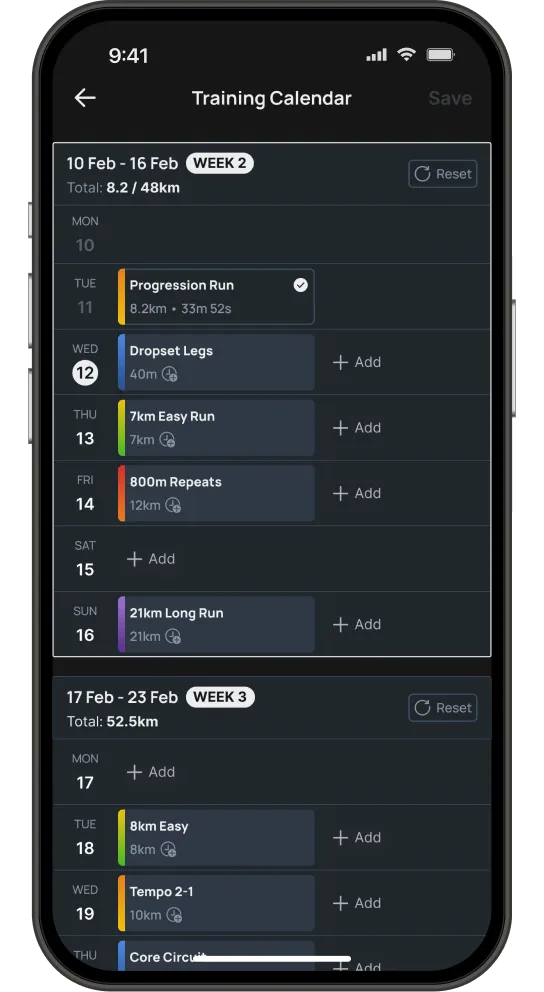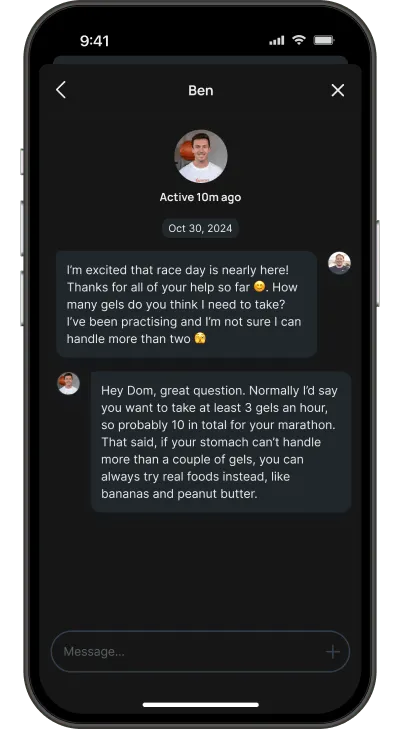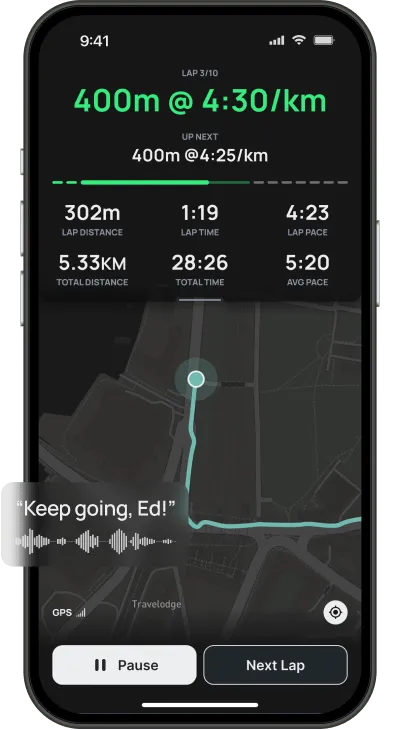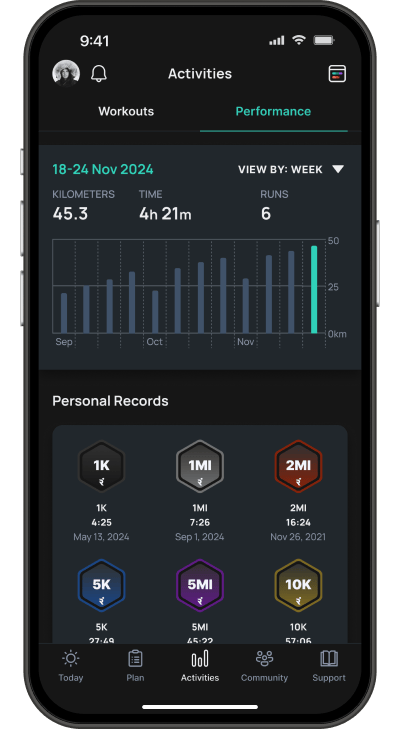Mobility Training Plan
Mobility is the foundation of strong, sustainable running. With the right training plan, you’ll unlock better range of motion, recover faster, and reduce your risk of injury.

Why do runners need mobility training?
Running builds endurance, strength, and mental resilience - but it doesn’t take your body through its full range of motion. That’s why supplementing your running with mobility training is important.
Mobility work is the missing link in many runners’ routines. By improving joint range of motion and muscle flexibility, it makes every stride smoother and more efficient. It also lowers your risk of strains and overuse injuries, keeping you consistent whether you’re training for your first 5k or building toward an ultramarathon.
Here’s how mobility training helps runners:
• Better range of motion: Mobility exercises help increase the range of motion of your joints and muscles.
• Injury prevention: Mobility training helps improve flexibility and reduces your risk of strains and sprains.
• Improved performance: When your joints move more freely and muscles work more efficiently, this helps reduce energy expenditure and boost your endurance (in combination with the right running plan, of course!).
• Faster recovery: Stretching is one of the ways to speed up recovery after long and challenging runs.
• Balance and coordination: Running requires coordination and balance, and mobility exercises improve stability to support this.
Runna’s mobility program fits seamlessly into your training plan, helping you move better, recover quicker, and stay strong.

Why choose our mobility training plan?
Whatever your running level and goals, we’ll help you move freer and stay stronger.
How to get started
Runna takes the guesswork out of mobility training. From day one, you’ll have clear, guided sessions that simply slot into your week - so you know exactly what to do.
Choose your plan
Select the Mobility Training Plan and we’ll build sessions around your running plan and life schedule - so mobility fits in effortlessly.
Download the app
Download the app, log in, and you’ll have your full training plan - complete with runs, tips, and guidance - at your fingertips.
Move, move, move!
Simply tap ‘Go’ and follow along. Every session is laid out clearly, so you always know exactly what to do.
Hit that goal
Stick with your plan and you’ll move more freely, recover faster, and feel stronger every time you run.
Tips for your mobility training plan
These expert-backed tips will help you train smarter, avoid injury, and stay motivated. From nutrition and recovery to gear and mindset, discover just a small snippet of all the tips and coaching advice you'll have at your fingertips with a Runna training plan.
Nutrition
Mobility helps you move better, recover faster, and stay injury-free with your running - but to really reap the rewards, you need the right nutrition alongside it. What you eat directly impacts how well your body repairs, adapts, and feels day to day.
- Keep protein high to rebuild muscles and support joint health.
- Eat plenty of colorful fruits and vegetables for vitamins and antioxidants that combat inflammation.
- Focus on whole, nutrient-rich foods like lean proteins, complex carbs (oats, quinoa, sweet potatoes, whole grains), and healthy fats from nuts, seeds, and olive oil.
- Limit heavily processed foods and excess sugar to help you avoid fatigue and muscle soreness.
Fuel for recovery
One of the best times to support mobility work is after a run:
- Pair protein with carbs (e.g. eggs on whole-grain toast, a smoothie with fruit and yogurt) to speed up recovery.
- Drink water regularly through the day to rehydrate and keep muscles loose.
- Keep snacks simple and balanced so your energy stays steady, not spiky.
Remember: Think of nutrition as a partner to your mobility training. When you fuel well and move well, you’ll recover quicker, stay consistent, and feel stronger in every run.
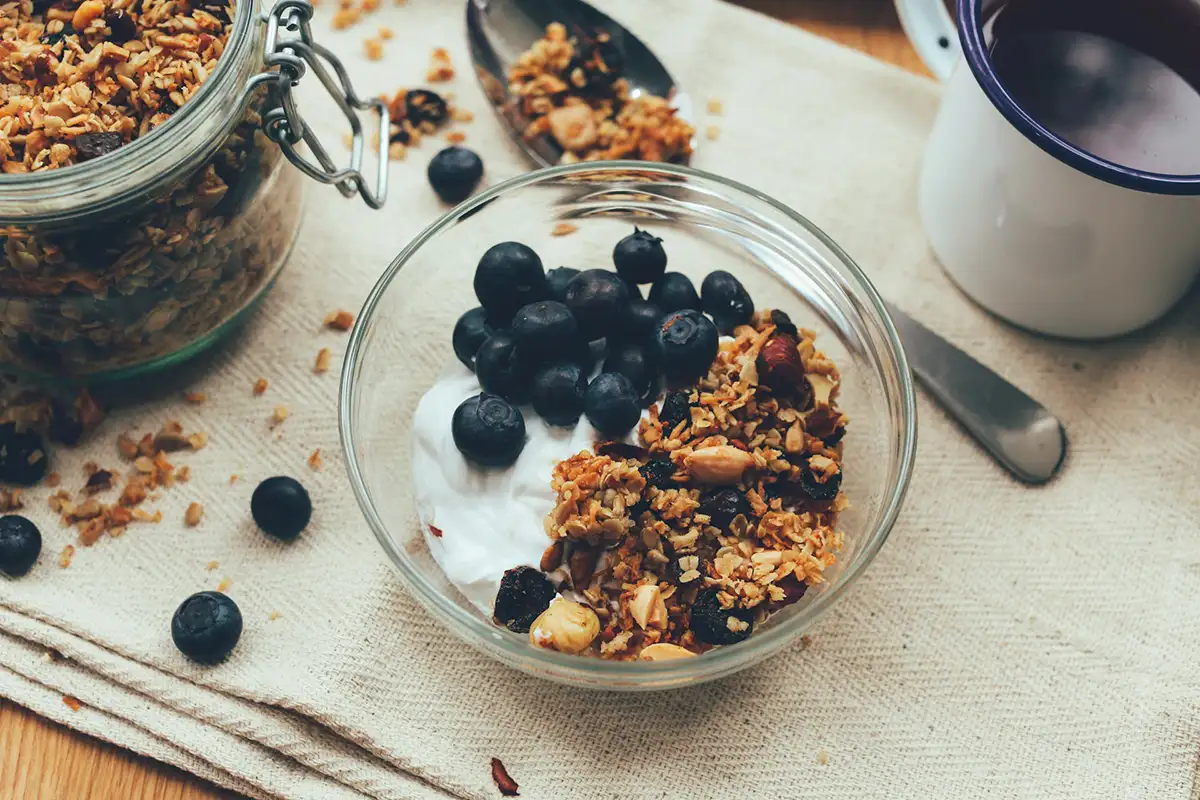
Cross-training and strength training
Cross-training and strength training build the fitness and power that support your miles, while mobility work gives you the freedom of movement and recovery you need to make the most of them. Together, they help you run stronger, stay consistent, and avoid injury.
Cross-training includes activities like cycling, swimming, rowing, or using the elliptical. These workouts improve cardiovascular fitness without the repetitive impact of running, giving your legs a break while keeping your aerobic base strong. Paired with mobility work, cross-training feels smoother and more efficient, thanks to improved flexibility and range of motion.
Strength training targets key muscle groups - calves, quads, glutes, hamstrings, and core - that power and protect your running. Just 1–2 short sessions a week can improve running economy by up to 8–12%, meaning you cover more ground with less effort. Add mobility into the mix and you’ll not only be stronger but also move with greater ease, reducing tightness and speeding up recovery.
With Runna, every part of your training fits together seamlessly, so you can train smarter and perform at your best.
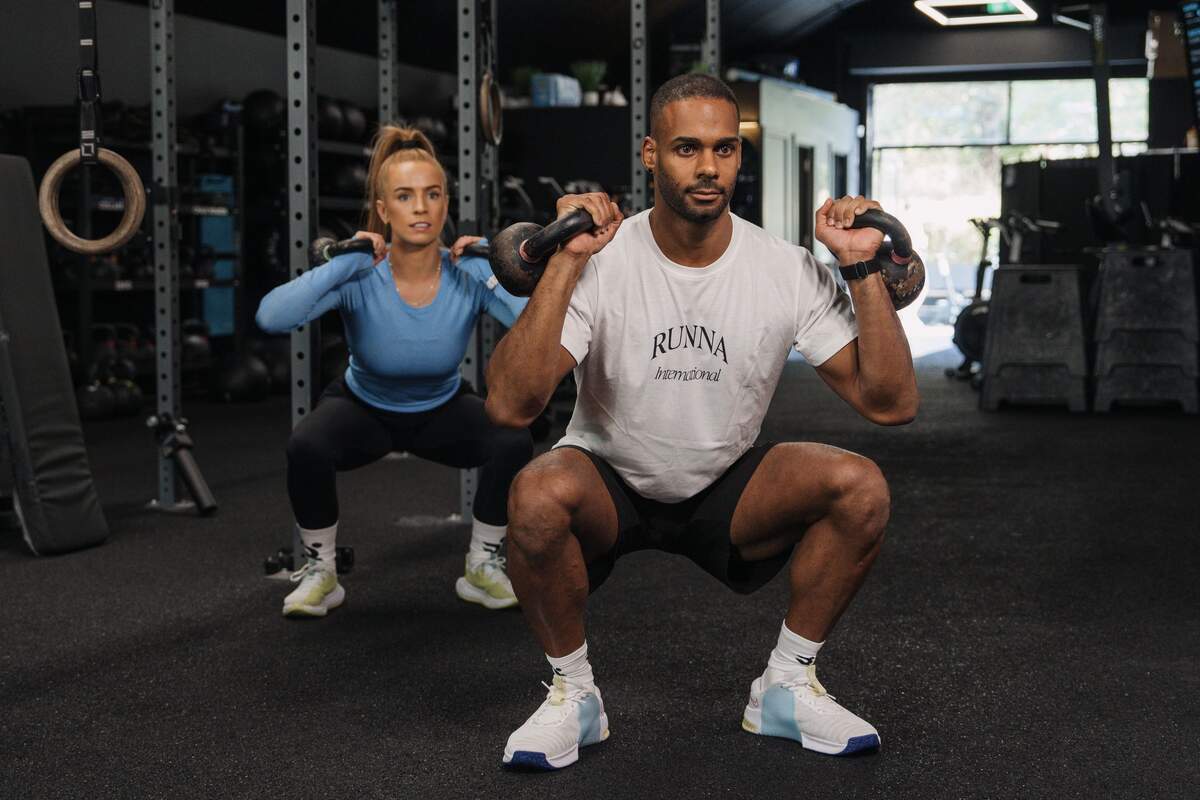
Mindset
In a sport where so much focus is on numbers - pace, distance, times - mobility gives you the chance to step back, move with intention, and build mental as well as physical strength.
Each session invites you to practice patience, awareness, and control. Moving deliberately through stretches and drills helps you tune into how your body feels, notice where you’re tight or imbalanced, and appreciate small improvements week by week. This focus builds confidence and reinforces consistency, making it easier to stay motivated even when running feels tough.
Mobility is also a reset for your mind. It gives you time to breathe deeply, release tension, and leave stress behind - so you return to your running calmer, more composed, and ready to perform. Many runners find it’s the missing balance in their training: a way to feel grounded, refreshed, and more resilient when challenges arise.
By training your mind as well as your body, mobility builds the resilience to stay consistent, push through setbacks, and keep progressing long after motivation alone fades.
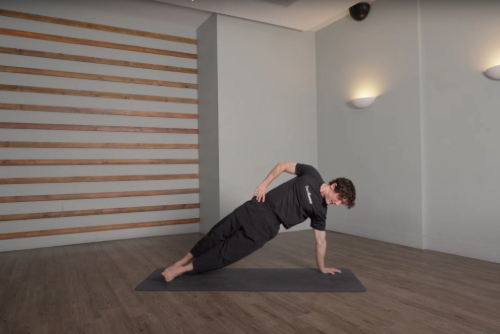
Form
Your movement form is just as important as your running form. How your joints move, how freely your muscles extend, and how balanced your body feels all carry over into your stride. Limited mobility or poor posture can lead to tightness, wasted energy, and a higher risk of injury over time. Mobility training helps you reset these patterns and move with greater ease and awareness.
Moving well will:
- Improve range of motion so you run more freely and efficiently.
- Reduce wasted energy by allowing smoother, more natural movement.
- Lower your risk of injury by loosening tight areas and addressing imbalances.
Good form isn’t about perfection - it’s about awareness and control. In each session, focus on:
- Standing tall with your spine aligned and core gently engaged.
- Keeping shoulders open and relaxed to avoid tension.
- Moving slowly and deliberately through each drill for full range of motion.
- Breathing steadily to support fluid, mindful movement.
Form takes time to improve, and progress comes from small, consistent adjustments. The more you practice in mobility sessions, the more natural good posture, efficient movement, and freer running will feel - in training and in everyday life.
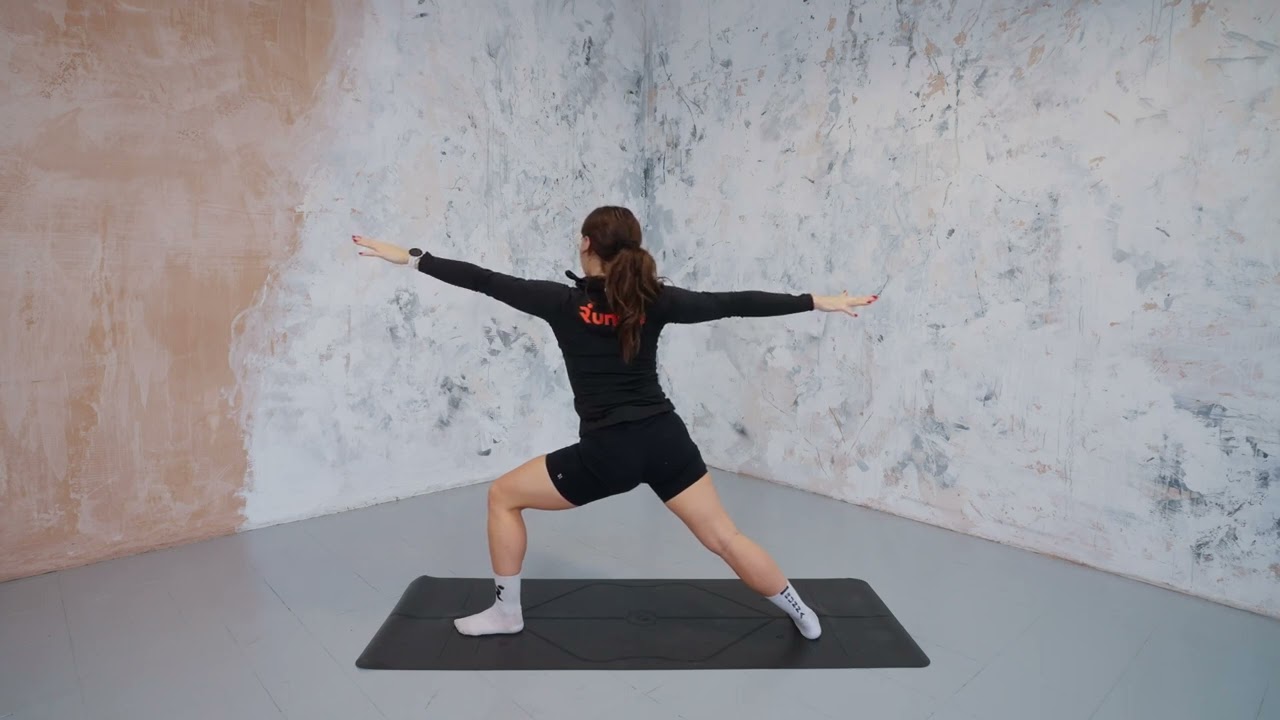
Recovery
Mobility is one of the best tools for recovery, but it works best when paired with other smart habits that keep your body balanced and resilient.
Here are some key things to focus on:
- Sleep: Aim for 7–9 hours each night. Quality sleep is when your body repairs tissues, adapts to training load, and restores energy.
- Massage and tools: Foam rolling, massage guns, or the occasional sports massage can complement your mobility plan by easing tight muscles and improving circulation.
- Nutrition and hydration: Eating a balanced diet rich in protein, complex carbs, and healthy fats supports muscle repair, while staying hydrated keeps joints supple and makes mobility work more effective.
- Active recovery: Low-intensity activities like walking, swimming, or cycling keep blood flowing and help muscles loosen without adding strain.
- Flexibility: Listen to your body. If you’re unusually sore or fatigued, it’s better to rest or adjust than to push through and risk injury.
Unlike race training, there’s no finish line here - mobility is designed to support you week after week, keeping your body moving freely and your running stronger for the long term.
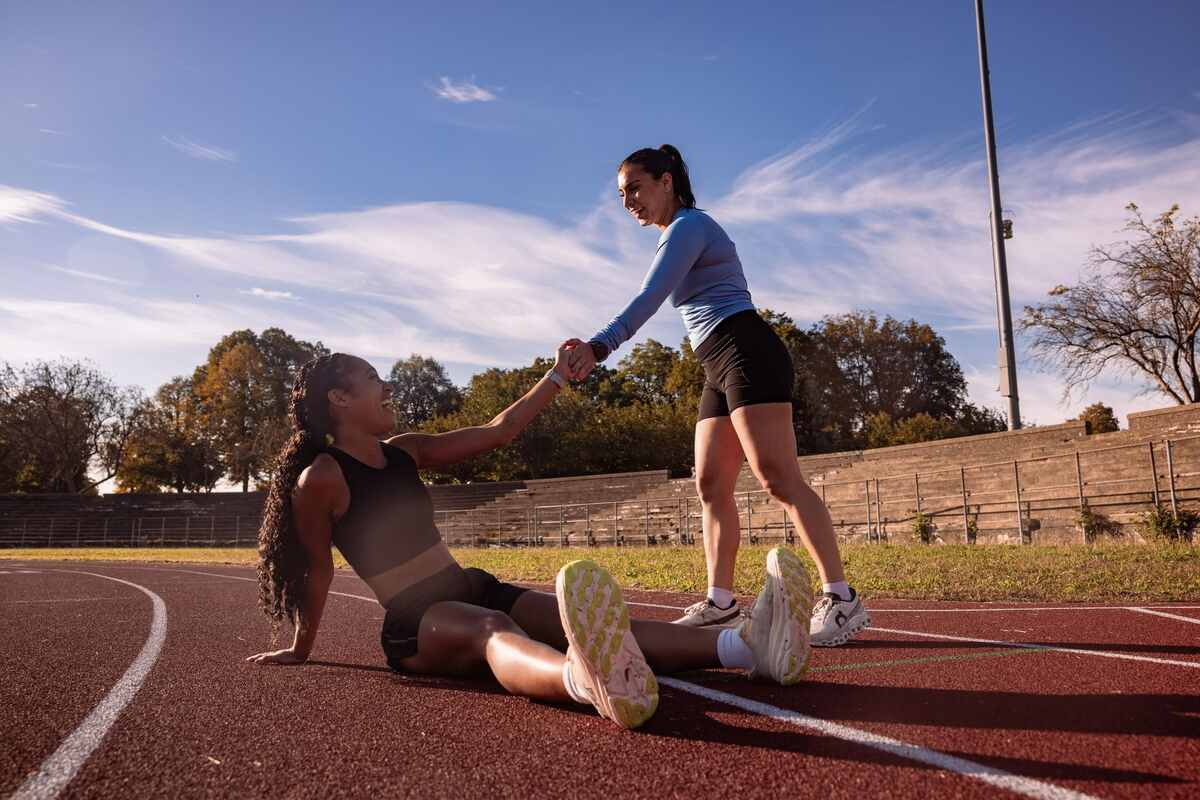
Gear
The setup you use for mobility sessions can make a real difference to both comfort and effectiveness. Here’s what to keep in mind:
- Mat: A yoga or exercise mat provides a stable, non-slip surface and cushions your joints during floor work.
- Space: Give yourself enough room to move through stretches without feeling cramped - an uncluttered space makes it easier to focus.
- Props: Tools like resistance bands, yoga blocks, or a small stability ball can add variety and help you progress, but every session can also be done with no equipment at all.
- Clothing: Wear lightweight, flexible kit that allows a full range of motion. Avoid anything restrictive around your hips and shoulders, as these are key areas you’ll be working on.
- Footwear: Most runners prefer to go barefoot or in socks to improve balance and control, though shoes are fine if you need extra support.
- Environment: Set up whatever helps you switch off and tune in - whether that’s calm music, guided audio, or simple quiet.
The easier and more comfortable your setup feels, the more likely you are to stick with your mobility routine week after week.
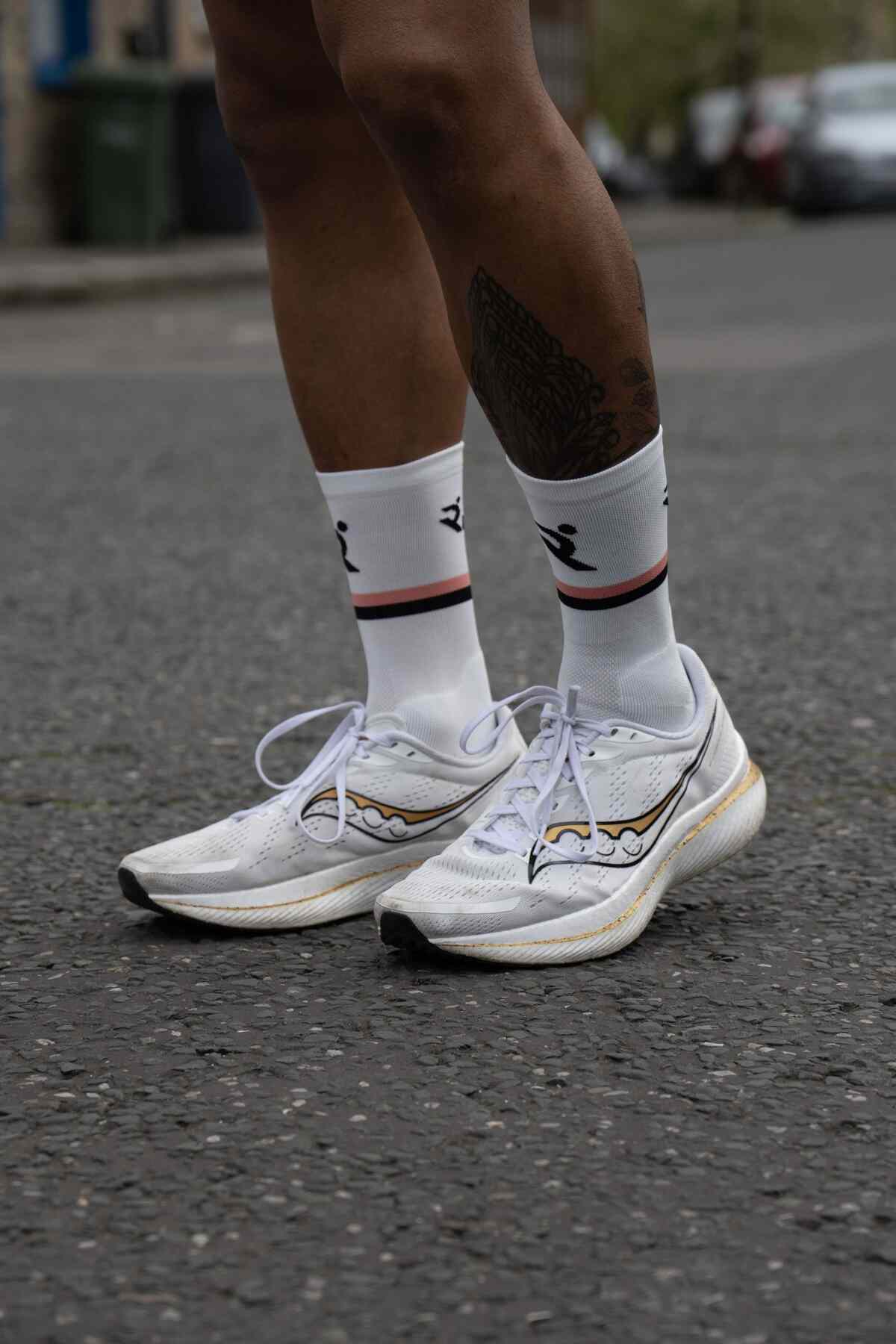
As featured in




Stories from Runnas
FAQ: All you need to know about mobility training
How can I improve my mobility as a runner?
To improve your mobility, spice up your routine with dynamic stretches, yoga poses, and foam rolling. Focus especially on the hips, ankles, and legs. This helps reduce stiffness, prevent niggles and injuries, and leads to smoother, more efficient stride movements.
How often should a runner do mobility workouts?
We advise doing regular warm-ups and cooldowns before and after your runs, and doing a full mobility and stretching session at a different day of the week, at least once weekly. With Runna, you can do all this from within the app! We have warm up stretches, cool down stretches, and a full mobility program for runners.
What is the difference between mobility and flexibility for runners?
Mobility refers to your body's ability to move through a range of motion during activity, whereas flexibility is about how far your muscles and joints can stretch statically.
Both are important for runners and serve different roles in your training.
Should I focus on mobility or flexibility?
Ideally, you should integrate both types of exercises into your running routine. Both help you improve your posture, stability, and running efficiency – and also reduce the risk of injuries. Mobility ensures fluid, efficient movements during your runs; flexibility helps keep your muscles supple and prevent injuries.
How do I become a flexible runner?
Add stretching sessions before and after your runs and include a weekly mobility or yoga workout in your routine. Runna enables you to do all this from a single place.
What are the benefits of mobility training for runners?
Mobility training helps enhance your stride length and efficiency, reduces your risk of injuries, and ensures you keep running smoothly. It’s also an excellent way to cool down after those longer runs, helping to speed up recovery.
Inspiration
.jpg)
Introduction to Mobility Training for Runners
Mobility training can help aid recovery and enhance your range of motion to help improve your running performance - here's why.

Top Tips to Maximize your Recovery
Here are all of our top tips to help you recover from your tough sessions as quickly as possible and keep those injuries at bay.

How to Fuel Your Training
Find out how to fuel and hydrate yourself before, during and after your runs with this handy overview guide.

